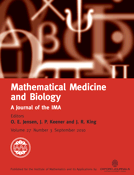-
Views
-
Cite
Cite
Katlyn N. Winter, Daniel M. Anderson, Richard J. Braun, A model for wetting and evaporation of a post-blink precorneal tear film, Mathematical Medicine and Biology: A Journal of the IMA, Volume 27, Issue 3, September 2010, Pages 211–225, https://doi.org/10.1093/imammb/dqp019
Close - Share Icon Share
Abstract
We examine a fluid dynamic model for the evolution of a precorneal tear film that includes evaporation of the aqueous layer and a wetting corneal surface. Our model extends previous work on the break-up time for a post-blink tear film to include a more realistic model for evaporation. The evaporation model includes the effects of conjoining pressure and predicts the existence of an equilibrium adsorbed fluid layer that serves as a model for a wetting corneal surface/mucin layer. The model allows the prediction of dewetting rates that are compared with experimental measurements. By choosing an expected thickness where evaporation and conjoining pressure balance, we obtain qualitative agreement for the opening rate with in vivo observations.





